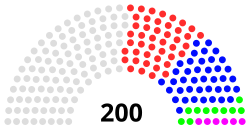Proportional representation
Proportional representation is a system used to elect people, usually to a country's parliament or other type of legislature.
Proportional representation works by taking the results of an election to decide how many seats each political party receives. It is calculated out of a political party's total number of votes in the election what that number is as a percentage (%) of all the votes cast in the election. This percentage is then equal to the amount of votes the party will receive. For example, if a party gets 20% of the vote, it will receive 20% of the seats in the legislature. Most countries have a minimum percentage a party has to receive to get seats. This minimum is usually between 3% and 5% of the total overall vote.[1]
Another way to run an election is the first-past-the-post system in which constituencies vote in one member. The United Kingdom works this way.
In most western countries, there is more than one political party. Most elected representatives will be a member of one or another party. If one party has an overall majority, then it forms the government. Otherwise the government must have members of more than one party.
Countries which use proportional representation include: Austria, Argentina, Belgium, Brazil, Bulgaria, Czech Republic, Denmark, Estonia, Finland, Greece, Iceland, Ireland, Israel, Netherlands, Norway, Poland, Portugal, Romania, Russia, South Africa, South Korea, Spain, Sri Lanka, Sweden, Switzerland and Turkey.
Countries which have systems that are similar or use semi-proportional representation include: Australia, Germany, Hungary, India, Republic of Ireland, Italy, Japan, Mexico, New Zealand, and Thailand.
Similar principles apply to sub-regions, who may have their own parliament or assembly.
Proportional Representation Media
References
- ↑ Difford, Dylan (3 September 2021). "Barriers to entry: How do electoral thresholds work?". Electoral Reform Society (ERS). https://www.electoral-reform.org.uk/barriers-to-entry-how-do-electoral-thresholds-work/. Retrieved 10 October 2023.








